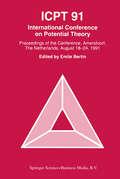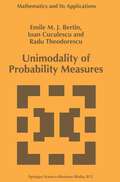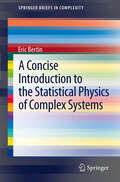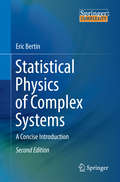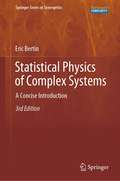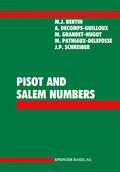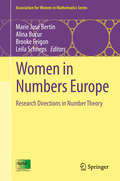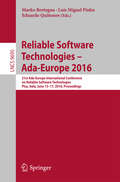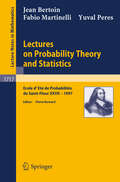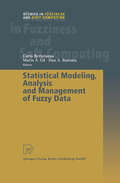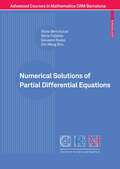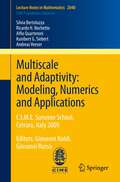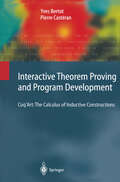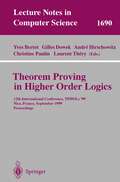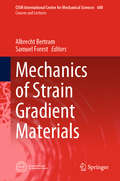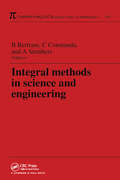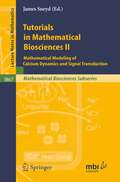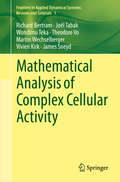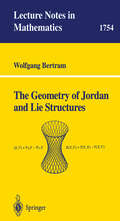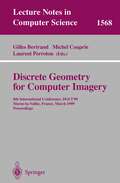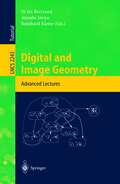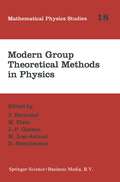- Table View
- List View
ICPT ’91: Proceedings from the International Conference on Potential Theory, Amersfoort, The Netherlands, August 18–24, 1991
by Emile M. J. BertinICPT91, the International Conference on Potential Theory, was held in Amersfoort, the Netherlands, from August 18--24, 1991. The volume consists of two parts, the first of which contains papers which also appear in the special issue of POTENTIAL ANALYSIS. The second part includes a collection of contributions edited and partly produced in Utrecht. Professor Monna wrote a preface reminiscing about his experiences with potential theory, mathematics and mathematicians during the last sixty years. The final pages contain a list of participants and a compact index.
Unimodality of Probability Measures (Mathematics and Its Applications #382)
by Emile M.J. Bertin I. Cuculescu Radu TheodorescuA Concise Introduction to the Statistical Physics of Complex Systems (SpringerBriefs in Complexity)
by Eric BertinThis concise primer (based on lectures given at summer schools on complex systems and on a masters degree course in complex systems modeling) will provide graduate students and newcomers to the field with the basic knowledge of the concepts and methods of statistical physics and its potential for application to interdisciplinary topics. Indeed, in recent years, statistical physics has begun to attract the interest of a broad community of researchers in the field of complex system sciences, ranging from biology to the social sciences, economics and computer science. More generally, a growing number of graduate students and researchers feel the need to learn some basic concepts and questions originating in other disciplines without necessarily having to master all of the corresponding technicalities and jargon. Generally speaking, the goals of statistical physics may be summarized as follows: on the one hand to study systems composed of a large number of interacting ‘entities’, and on the other to predict the macroscopic (or collective) behavior of the system considered from the microscopic laws ruling the dynamics of the individual ‘entities’. These two goals are, to some extent, also shared by what is nowadays called ‘complex systems science’ and for these reasons, systems studied in the framework of statistical physics may be considered as among the simplest examples of complex systems—allowing in addition a rather well developed mathematical treatment.
Statistical Physics of Complex Systems: A Concise Introduction (Springerbriefs In Complexity Ser.)
by Eric BertinThis course-tested primer provides graduate students and non-specialists with a basic understanding of the concepts and methods of statistical physics and demonstrates their wide range of applications to interdisciplinary topics in the field of complex system sciences, including selected aspects of theoretical modeling in biology and the social sciences. Generally speaking, the goals of statistical physics may be summarized as follows: on the one hand to study systems composed of a large number of interacting units, and on the other to predict the macroscopic, collective behavior of the system considered from the perspective of the microscopic laws governing the dynamics of the individual entities. These two goals are essentially also shared by what is now called 'complex systems science,' and as such, systems studied in the framework of statistical physics may be considered to be among the simplest examples of complex systems – while also offering a rather well developed mathematical treatment. The second edition has been significantly revised and expanded, featuring in particular three new chapters addressing non-conserved particles, evolutionary population dynamics, networks, properties of both individual and coupled simple dynamical systems, and convergence theorems, as well as short appendices that offer helpful hints on how to perform simple stochastic simulations in practice. Yet, the original spirit of the book – to remain accessible to a broad, non-specialized readership – has been kept throughout: the format is a set of concise, modular and self-contained topical chapters, avoiding technicalities and jargon as much as possible, and complemented by a wealth of worked-out examples, so as to make this work useful as a self-study text or as textbook for short courses. From the reviews of the first edition: “… a good introduction to basic concepts of statistical physics and complex systems for students and researchers with an interest in complex systems in other fields … .” Georg Hebermehl, Zentralblatt MATH, Vol. 1237, 2012 “… this short text remains very refreshing for the mathematician.” Dimitri Petritis, Mathematical Reviews, Issue 2012k
Statistical Physics of Complex Systems: A Concise Introduction (Springer Series in Synergetics)
by Eric BertinThis third edition of Statistical Physics of Complex Systems has been expanded to provide more examples of applications of concepts and methods from statistical physics to the modeling of complex systems. These include avalanche dynamics in materials, models of social agents like road traffic or wealth repartition, the real space aspects of biological evolution dynamics, propagation phenomena on complex networks, formal neural networks and their connection to constraint satisfaction problems.This course-tested textbook provides graduate students and non-specialists with a basic understanding of the concepts and methods of statistical physics and demonstrates their wide range of applications to interdisciplinary topics in the field of complex system sciences, including selected aspects of theoretical modeling in biology and the social sciences. It covers topics such as non-conserved particles, evolutionary population dynamics, networks, properties of both individual and coupled simple dynamical systems, and convergence theorems, as well as short appendices that offer helpful hints on how to perform simple stochastic simulations in practice. The original spirit of the book is to remain accessible to a broad, non-specialized readership. The format is a set of concise, modular, and self-contained topical chapters, avoiding technicalities and jargon as much as possible, and complemented by a wealth of worked-out examples, so as to make this work useful as a self-study text or as textbook for short courses.
Pisot and Salem Numbers
by Marie J. Bertin Annette Decomps-Guilloux Marthe Grandet-Hugot Martine Pathiaux-Delefosse Jean Schreiberthe attention of The publication of Charles Pisot's thesis in 1938 brought to the mathematical community those marvelous numbers now known as the Pisot numbers (or the Pisot-Vijayaraghavan numbers). Although these numbers had been discovered earlier by A. Thue and then by G. H. Hardy, it was Pisot's result in that paper of 1938 that provided the link to harmonic analysis, as discovered by Raphael Salem and described in a series of papers in the 1940s. In one of these papers, Salem introduced the related class of numbers, now universally known as the Salem numbers. These two sets of algebraic numbers are distinguished by some striking arith metic properties that account for their appearance in many diverse areas of mathematics: harmonic analysis, ergodic theory, dynamical systems and alge braic groups. Until now, the best known and most accessible introduction to these num bers has been the beautiful little monograph of Salem, Algebraic Numbers and Fourier Analysis, first published in 1963. Since the publication of Salem's book, however, there has been much progress in the study of these numbers. Pisot had long expressed the desire to publish an up-to-date account of this work, but his death in 1984 left this task unfulfilled.
Women in Numbers Europe: Research Directions in Number Theory (Association for Women in Mathematics Series #2)
by Marie José Bertin Alina Bucur Brooke Feigon Leila SchnepsCovering topics in graph theory, L-functions, p-adic geometry, Galois representations, elliptic fibrations, genus 3 curves and bad reduction, harmonic analysis, symplectic groups and mould combinatorics, this volume presents a collection of papers covering a wide swath of number theory emerging from the third iteration of the international Women in Numbers conference, “Women in Numbers - Europe” (WINE), held on October 14–18, 2013 at the CIRM-Luminy mathematical conference center in France. While containing contributions covering a wide range of cutting-edge topics in number theory, the volume emphasizes those concrete approaches that make it possible for graduate students and postdocs to begin work immediately on research problems even in highly complex subjects.
Roles, Trust, and Reputation in Social Media Knowledge Markets: Theory and Methods (Computational Social Sciences)
by Elisa Bertino Sorin Adam MateiKnowledge and expertise, especially of the kind that can shape public opinion, have been traditionally the domain of individuals holding degrees awarded by higher learning institutions or occupying formal positions in notable organizations. Expertise is validated by reputations established in an institutionalized marketplace of ideas with a limited number of “available seats” and a stringent process of selection and retention of names, ideas, topics and facts of interest. However, the social media revolution, which has enabled over two billion Internet users not only to consume, but also to produce information and knowledge, has created a secondary and very active informal marketplace of ideas and knowledge. Anchored by platforms like Wikipedia, YouTube, Facebook and Twitter, this informal marketplace has low barriers to entry and has become a gigantic and potentially questionable, knowledge resource for the public at large. Roles, Trust and Reputation in Social Media Knowledge Markets will discuss some of the emerging trends in defining, measuring and operationalizing reputation as a new and essential component of the knowledge that is generated and consumed online. The book will propose a future research agenda related to these issues. The ultimate goal of research agenda being to shape the next generation of theoretical and analytic strategies needed for understanding how knowledge markets are influenced by social interactions and reputations built around functional roles. The authors, including leading scholars and young innovators, will share with the readers some of the main lessons they have learned from their own work in these areas and will discuss the issues, topics and sub-areas that they find under-studied or that promise the greatest intellectual payoff in the future. The discussion will be placed in the context of social network analysis and “big data” research. Roles, Trust and Reputation in Social Media Knowledge Markets exposes issues that have not been satisfactorily dealt with in the current literature, as the research agenda in reputation and authorship is still emerging. In a broader sense, the volume aims to change the way in which knowledge generation in social media spaces is understood and utilized. The tools, theories and methodologies proposed by the contributors offer concrete avenues for developing the next generation of research strategies and applications that will help: tomorrow’s information consumers make smarter choices, developers to create new tools and researchers to launch new research programs.
Reliable Software Technologies – Ada-Europe 2016: 21st Ada-Europe International Conference on Reliable Software Technologies, Pisa, Italy, June 13-17, 2016, Proceedings (Lecture Notes in Computer Science #9695)
by Marko Bertogna Luis Miguel Pinho Eduardo QuiñonesThis book constitutes the refereed proceedings of the 21st Ada-Europe International Conference on Reliable Software Technologies, Ada-Europe 2016, held in Pisa, Italy, in June 2016. The revised 12 full papers presented together with one invited paper were carefully reviewed and selected from 28 submissions. They are organized in topical sections on concurrency and parallelism, testing and verification, program correctness and robustness, and real-time systems.
Lectures on Probability Theory and Statistics: Ecole d'Ete de Probabilites de Saint-Flour XXVII - 1997 (Lecture Notes in Mathematics #1717)
by J. Bertoin F. Martinelli Y. PeresStatistical Modeling, Analysis and Management of Fuzzy Data (Studies in Fuzziness and Soft Computing #87)
by Carlo Bertoluzza Maria A. Gil Dan A. RalescuThe contributions in this book state the complementary rather than competitive relationship between Probability and Fuzzy Set Theory and allow solutions to real life problems with suitable combinations of both theories.
Numerical Solutions of Partial Differential Equations (Advanced Courses in Mathematics - CRM Barcelona)
by Silvia Bertoluzza Silvia Falletta Giovanni Russo Chi-Wang ShuMultiscale and Adaptivity: C.I.M.E. Summer School, Cetraro, Italy 2009 (Lecture Notes in Mathematics #2040)
by Silvia Bertoluzza Ricardo H. Nochetto Alfio Quarteroni Kunibert G. Siebert Andreas VeeserThis book is a collection of lecture notes for the CIME course on "Multiscale and Adaptivity: Modeling, Numerics and Applications," held in Cetraro (Italy), in July 2009. Complex systems arise in several physical, chemical, and biological processes, in which length and time scales may span several orders of magnitude. Traditionally, scientists have focused on methods that are particularly applicable in only one regime, and knowledge of the system on one scale has been transferred to another scale only indirectly. Even with modern computer power, the complexity of such systems precludes their being treated directly with traditional tools, and new mathematical and computational instruments have had to be developed to tackle such problems. The outstanding and internationally renowned lecturers, coming from different areas of Applied Mathematics, have themselves contributed in an essential way to the development of the theory and techniques that constituted the subjects of the courses.
Inconsistency Tolerance (Lecture Notes in Computer Science #3300)
by Leopoldo Bertossi Anthony Hunter Torsten SchaubInconsistency arises in many areas in advanced computing. Often inconsistency is unwanted, for example in the specification for a plan or in sensor fusion in robotics; however, sometimes inconsistency is useful. Whether inconsistency is unwanted or useful, there is a need to develop tolerance to inconsistency in application technologies such as databases, knowledge bases, and software systems. To address this situation, inconsistency tolerance is being built on foundational technologies for identifying and analyzing inconsistency in information, for representing and reasoning with inconsistent information, for resolving inconsistent information, and for merging inconsistent information. The idea for this book arose out of a Dagstuhl Seminar on the topic held in summer 2003. The nine chapters in this first book devoted to the subject of inconsistency tolerance were carefully invited and anonymously reviewed. The book provides an exciting introduction to this new field.
Interactive Theorem Proving and Program Development: Coq’Art: The Calculus of Inductive Constructions (Texts in Theoretical Computer Science. An EATCS Series)
by Yves Bertot Pierre CastéranA practical introduction to the development of proofs and certified programs using Coq. An invaluable tool for researchers, students, and engineers interested in formal methods and the development of zero-fault software.
Theorem Proving in Higher Order Logics: 12th International Conference, TPHOLs'99, Nice, France, September 14-17, 1999, Proceedings (Lecture Notes in Computer Science #1690)
by Yves Bertot Gilles Dowek Andre Hirschowitz Christine Paulin Laurent TheryMechanics of Strain Gradient Materials (CISM International Centre for Mechanical Sciences #600)
by Albrecht Bertram Samuel ForestOver the past 50 years, strain gradient material theories have been developed for the continuum modeling of size effects in materials and structures in terms of their elasticity, plasticity and fracturing. This book puts forward a unifying perspective to combine existing theories involving the higher order gradient of the strain tensor, or of plastic strain. It begins by reviewing experimental findings on the existence (or non-existence) of size effects on the mechanics of materials. In turn, the book devises first, second and higher order strain gradient theories from general principles, and presents constitutive frameworks that satisfy thermodynamic requirements. The special case of strain gradient plasticity is then developed and illustrated via computational analyses of size effects on the plasticity of metals at small scales. In closing, the book explains the origin of gradient effects in the case of lattice structures by drawing on homogenization theory.
Integral Methods in Science and Engineering (Chapman And Hall/crc Research Notes In Mathematics Ser.)
by Barbara S. Bertram Christian Constanda Allan A. StruthersBased on proceedings of the International Conference on Integral Methods in Science and Engineering, this collection of papers addresses the solution of mathematical problems by integral methods in conjunction with approximation schemes from various physical domains. Topics and applications include: wavelet expansions, reaction-diffusion systems, variational methods , fracture theory, boundary value problems at resonance, micromechanics, fluid mechanics, combustion problems, nonlinear problems, elasticity theory, and plates and shells.
Lernprozesse von Lehrkräften im Rahmen einer Fortbildung zu inklusivem Mathematikunterricht (Essener Beiträge zur Mathematikdidaktik)
by Jennifer BertramFür eine effektive und systematische Fortbildungsgestaltung ist das Wissen über typische Lernprozesse von Lehrkräften von besonderer Bedeutung. Bisher gibt es noch keine umfangreichen empirischen Forschungserkenntnisse mit Blick auf die Betrachtung gegenstandsbezogener, d.h. für den konkreten Fortbildungsgegenstand spezifizierter Lernprozesse im Bereich eines inklusiven Mathematikunterrichts. Inklusiver Mathematikunterricht wird dabei verstanden als ein Unterricht, der die Heterogenität aller Schülerinnen und Schüler berücksichtigt und ihnen fachliche Zugänglichkeit sowie soziale Teilhabe ermöglicht. Die vorliegende Arbeit untersucht deswegen gegenstandsbezogene Lernprozesse von Lehrkräften im Rahmen einer Fortbildung zu inklusivem Mathematikunterricht (in der Sekundarstufe I) und geht den zentralen Fragen nach, welche typischen Lernwege der Lehrkräfte identifiziert werden können und inwiefern diese eine Verbindung zum Fortbildungsinhalt aufweisen.
Tutorials in Mathematical Biosciences II: Mathematical Modeling of Calcium Dynamics and Signal Transduction (Lecture Notes in Mathematics #1867)
by R. Bertram J. L. Greenstein R. Hinch E. Pate J. Reisert M. J. Sanderson T. R. Shannon J. Sneyd R. L. WinslowThis book presents a series of models in the general area of cell physiology and signal transduction, with particular attention being paid to intracellular calcium dynamics, and the role played by calcium in a variety of cell types. Calcium plays a crucial role in cell physiology, and the study of its dynamics lends insight into many different cellular processes. In particular, calcium plays a central role in muscular contraction, olfactory transduction and synaptic communication, three of the topics to be addressed in detail in this book. In addition to the models, much of the underlying physiology is presented, so that readers may learn both the mathematics and the physiology, and see how the models are applied to specific biological questions. It is intended primarily as a graduate text or a research reference. It will serve as a concise and up-to-date introduction to all those who wish to learn about the state of calcium dynamics modeling, and how such models are applied to physiological questions.
Mathematical Analysis of Complex Cellular Activity (Frontiers in Applied Dynamical Systems: Reviews and Tutorials #1)
by Richard Bertram Joel Tabak Wondimu Teka Theodore Vo Martin Wechselberger Vivien Kirk James SneydThis book contains two review articles on mathematical physiology that deal with closely related topics but were written and can be read independently.The first article reviews the basic theory of calcium oscillations (common to almost all cell types), including spatio-temporal behaviors such as waves. The second article uses, and expands on, much of this basic theory to show how the interaction of cytosolic calcium oscillators with membrane ion channels can result in highly complex patterns of electrical spiking. Through these examples one can see clearly how multiple oscillatory processes interact within a cell, and how mathematical methods can be used to understand such interactions better. The two reviews provide excellent examples of how mathematics and physiology can learn from each other, and work jointly towards a better understanding of complex cellular processes.Review 1: Richard Bertram, Joel Tabak, Wondimu Teka, Theodore Vo, Martin Wechselberger: Geometric Singular Perturbation Analysis of Bursting Oscillations in Pituitary CellsReview 2: Vivien Kirk, James Sneyd: Nonlinear Dynamics of Calcium
Discrete Geometry for Computer Imagery: 8th International Conference, DGCI'99, Marne-la-Vallee, France, March 17-19, 1999 Proceedings (Lecture Notes in Computer Science #1568)
by Gilles Bertrand Michel Couprie Laurent PerrotonThese proceedings contain papers presented at the 8th Discrete Geometry for Computer Imagery conference, held 17-19, March 1999 at ESIEE, Marne-la- Vall ee. The domains of discrete geometry and computer imagery are closely related. Discrete geometry provides both theoretical and algorithmic models for the p- cessing, analysis and synthesis of images; in return computer imagery, in its variety of applications, constitutes a remarkable experimentational eld and is a source of challenging problems. The number of returning participants, the arrival each year of contributions from new laboratories and new researchers, as well as the quality and originality of the results have contributed to the success of the conference and are an - dication of the dynamism of this eld. The DGCI has become one of the major conferences related to this topic, including participating researchers and la- ratories from all over the world. Of the 41 papers received this year, 24 have been selected for presentation and 7 for poster sessions. In addition to these, four invited speakers have contributed to the conference. The site of Marne-la-Vall ee, just 20 min away from Paris, is particularly we- suited to hold the conference. Indeed, as a newly built city, it showcases a great amount of modern creative architecture, whose pure lines and original shapes o er a favorable context for the topic of Geometry.
Digital and Image Geometry: Advanced Lectures (Lecture Notes in Computer Science #2243)
by Gilles Bertrand Atsushi Imiya Reinhard KletteImages or discrete objects, to be analyzed based on digital image data, need to be represented, analyzed, transformed, recovered etc. These problems have stimulated many interesting developments in theoretical foundations of image processing. This coherent anthology presents 27 state-of-the-art surveys and research papers on digital image geometry and topology. It is based on a winter school held at Dagstuhl Castle, Germany in December 2000 and offers topical sections on topology, representation, geometry, multigrid convergence, and shape similarity and simplification.
Modern Group Theoretical Methods in Physics: Proceedings of the Conference in Honour of Guy Rideau (Mathematical Physics Studies #18)
by J. Bertrand M. Flato J. P. Gazeau M. Irac-Astaud Daniel SternheimerThis book contains the proceedings of a meeting that brought together friends and colleagues of Guy Rideau at the Université Denis Diderot (Paris, France) in January 1995. It contains original results as well as review papers covering important domains of mathematical physics, such as modern statistical mechanics, field theory, and quantum groups. The emphasis is on geometrical approaches. Several papers are devoted to the study of symmetry groups, including applications to nonlinear differential equations, and deformation of structures, in particular deformation-quantization and quantum groups. The richness of the field of mathematical physics is demonstrated with topics ranging from pure mathematics to up-to-date applications such as imaging and neuronal models. Audience: Researchers in mathematical physics.
